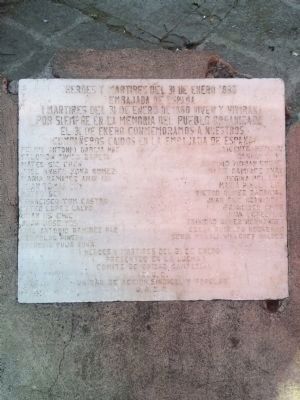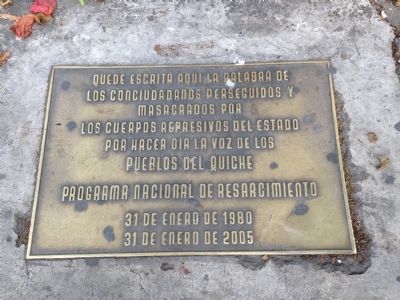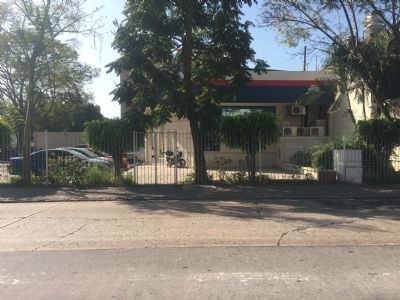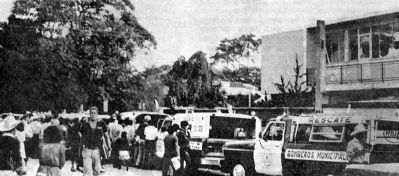Guatemala City in Guatemala Department, — Central America
Fire at the Spanish Embassy in Guatemala
Incendio de la Embajada de España en Guatemala
los conciudadanos perseguidos y
masacrados por
los cuerpos represivos del estado
por hacer oir la voz de los
pueblos del Quiche
Programa Nacional de Resarcimiento
31 de enero de 1980
31 de enero de 2005
those fellow citizens persecuted and
massacred here by
the repressive actors of the State
for making the voice of the Quiche people heard
National Compensation Program of Guatemala
January 31, 1980
January 31, 2005
Erected 2005 by National Compensation Program of Guatemala.
Topics. This historical marker is listed in this topic list: Notable Events. A significant historical month for this entry is January 1815.
Location. 14° 36.234′ N, 90° 31.179′ W. Marker is in Guatemala City, Guatemala (Guatemala Department). Marker is at the intersection of 10a Calle and 6a Avenida "A", on the left when traveling west on 10a Calle . The marker is embedded into the sidewalk to the north of a Reformador Bank at 10a Calle and 6a Avenida "A". Touch for map. Marker is in this post office area: Guatemala City, Guatemala 01009, Guatemala. Touch for directions.
Other nearby markers. At least 8 other markers are within walking distance of this marker. Bernal Diaz de Castillo (approx. 0.3 kilometers away); Ramiro Samayoa Martínez (approx. 0.6 kilometers away); Memorial to United States Officials in Guatemala (approx. 0.6 kilometers away); Miguel Hidalgo y Costilla (approx. 0.6 kilometers away); The Ceiba, Guatemala's National Tree (approx. 0.7 kilometers away); La Reforma Avenue (approx. 0.7 kilometers away); Israel and Guatemala Monument (approx. 0.8 kilometers away); Assassination of Manuel Colom Argueta (approx. 0.8 kilometers away). Touch for a list and map of all markers in Guatemala City.
Regarding Fire at the Spanish Embassy in Guatemala. On January 31, 1980, indigenous representatives of Maya organizations accompanied by university students peacefully entered the Spanish Embassy. Their main goal was to bring urgent attention to the atrocities that the Guatemalan military had committed in their communities. In early December 1979, the country's army executed peasant farmers in Northern El Quiche. This event, known as the Massacre in Chajul, fueled community leaders to take a collective stance against the years of threats and violations of human rights. The representatives traveled
to Guatemala City where they attempted to create awareness of this situation. Their voiced concerns fell on deaf ears. Their visits to the Office of American States, the national congress, and local press offices, were ignored. The group knew they needed to bring attention to their efforts. Of all the Embassies in the city, the Spanish Embassy had fewer security barriers.
At 11:00 A.M., the group entered the Embassy without the use of aggressive force. Within minutes, large numbers of security forces, at least 300 heavily armed men including municipal police, Detective Corps (“la judicial”), G2 (army intelligence), Pelotón Modelo (anti-riot), and the SWAT-inspired Commando Seis of the National Police, began to amass around 11:45, quickly surrounding the building and cordoning off the area to vehicular traffic. They left the journalists and crowding bystanders alone, surprising journalists who remembered how restricted their movements had been at previous embassy occupations. Almost immediately, the security forces forced the key from an Embassy office worker returning from running errands and entered through the front door. One group of security forces approached the building from the rear and climbed onto the balcony and roof. According to the Ambassador, within fifteen minutes, this security force advance had forced the occupiers to move everyone upstairs, climbing a staircase which opened onto a small foyer. The foyer had a door to every other room on the second floor: (clockwise from the stairwell) the waiting room, the Chancellor’s office, a bathroom, the Ambassador’s office, and a secretary’s office. The large balcony, about 2/3 the size of the second floor, was accessible through a door in the waiting room. A metal grate door guarded the top of the stairwell, which the occupiers locked behind them. Shortly after the arrival of the security forces, then, the occupiers and the hostages found themselves separated from the advancing agents only by this metal grate door. Once locked upstairs, there was a flurry of activity. Increasingly anxious, occupiers and hostages made telephone calls and used megaphones demanding the police back down. Security forces allowed reporters inside to talk to the hostages through the metal grate separating the two opposing groups. While huddled around the top of the stairwell, the Ambassador and the other prominent hostages kept asking for a responsible intermediary; the police only shrugged their shoulders, indicating they were “merely underlings” following orders. No one who claimed any authority appeared.
Knowing the potential for escalating violence, the Spanish ambassador called the Ministry of Foreign Relations to request the immediate withdrawal of the national police from

Photographed By J. Makali Bruton, August 1, 2015
4. Another Spanish Embassy Fire marker
This additional marker can be found at the Guatemalan General Cemetery and translated into English reads: "Heroes and martyrs of January 31st, 1980, Spanish Embassy, Martyrs of January 31, 1980 live and will live always in the memory of the organized peoples. On January 31 we commemorate our fallen companions at the Spanish Embassy, Felipe Antonio Garcia Pac, Salomon Tavico Zapeta, Mateo Sic Chen, Jose Angel Xona Gomez, Maria Ramirez Anay (2), Juan Tomas Cux, Mateo Sen, Francisco Tum Castro, Mateo Lopen Calvo, Juan Us Chic, Juan Jose Yos, Luis Antonio Ramirez Paz, Leopoldo Pineda, Gregorio Yuja Zona, Vicente Menchu, Gaspar Vivi, Gabino Moran Chupe, Maria Ramirez Anay, Regina Pol Cuy, Maria Pinula Lux, Victor Gomez Zacarias, Juan Chic Hernandez, Francisco Chen, Juan Lopez Yac, Trinidad Gomez Hernandez, Edgar Rodolfo Negreros,Sonia Magali Welches Valdez
Heroes and Martyrs of January 31 present in the struggle! Peasant Unity Committee (CUC), Labor and Popular Accion Union (UASP).
An explosion occurred followed by a fire killing ten hostages and twenty seven occupiers. The police refused to unblock the doors or allow firefighters to enter. Spanish consul Jaime Ruiz Arvore, former Guatemalan vice president Eduardo Cáceres Lehnhoff (1970-74) and former Guatemalan foreign relations minister Adolfo Molina were in a diplomatic meeting that same morning. All of them died along with the protesters. One protester survived the fire, but he was kidnapped and murdered by armed men after being hospitalized. The only other survivor was Spanish ambassador Máximo Cajal y López.
There have been many debates regarding the events that led to the fire that day. Some claim security forces started the fire, and others blame the students accompanying the indigenous delegation, whose molotov cocktails exploded while inside. Compounding the confusion is the fact that there was no physical evidence because Guatemalan authorities never conducted the autopsies required by law in violent or accidental deaths.
On January 30th, the Spanish ambassador had traveled to El Quiche to meet with Spanish clergy. The army's repression in the area had threatened the ministry and lives of local priests, the Ambassador visited and offered support to help them leave the country. Because of this visit, some have accused the ambassador as having planned this event along with the indigenous community leaders. The Spanish government condemned the behavior of the Guatemalan authorities requesting an official investigation of the event. The country's UN sponsored truth commission, the Comisión para el Esclarecimiento Histórico (CEH) considers that the occupants had the sole intention of publicly denouncing the violations of their community's human rights. Their resolution called the occupiers’ deaths “the grandest demonstration of her children’s sacrifice for the Nation.” Following the lead of a 1998 Congressional resolution, Guatemala’s two major post-war truth commissions, the CEH and the Recovery of Historical Memory Project prepared by the Guatemalan Archdiocese’s Human Rights Office (REHMI), has devoted considerable attention to the tragedy in their 1999 reports, with the CEH commemorating the occupiers as “martyrs for peace,” exactly the opposite of the military’s “psychopathic terrorists.”
The CEH formally recognizes that "a group of peasant farmers brought the suffering, needs, and petitions of people living in poverty and extreme poverty, the majority of the Guatemalan population, to a debate by taking the Spanish Embassy whose only goal was to bring awareness to this situation… and that historical memory is part of a social culture, the same that should become an inspiration of reconciliation and peace, so that these acts shall never be repeated in Guatemalan society."
Source: Memory of Silence: The Guatemalan Truth Commission Report 1999
Credits. This page was last revised on May 29, 2020. It was originally submitted on January 12, 2015, by J. Makali Bruton of Accra, Ghana. This page has been viewed 1,123 times since then and 202 times this year. Photos: 1, 2, 3, 4. submitted on January 12, 2015, by J. Makali Bruton of Accra, Ghana. • Andrew Ruppenstein was the editor who published this page.


